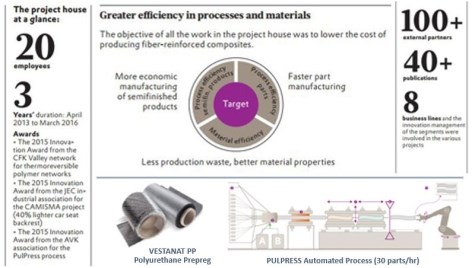Reversibly crosslinking thermoset-thermoplastic hybrid polymers
Evonik’s new system delivers crosslinked performance of epoxies below 100°C, processing benefits of thermoplastics above 170°C.

Evonik is a specialty chemicals company based in Essen, Germany. It has a strategic innovation unit, called Creavis, which develops new competencies for Evonik by launching Project Houses — cross-organizational ventures with a specific aim and timeline.
Established in 2013, Evonik’s Composites Project House has developed new materials and system solutions for lightweight construction, mostly aimed at automotive, transportation and energy applications. One example is VESTANAT PP polyurethane prepreg which offers room-temp storage, 2-3 minute cure in a 180°C compression molding press and a reportedly 35% cost savings vs. RTM. Another development is the PulPress automated process which braids fiber reinforcements around ROHOCELL polymethacrylimide (PMI) foam, injects 2-part resin into the preform and cures in mobile press cells to create 3D sandwich structures up to 1.2 m long on a continuous basis at a reported rate of 30 parts/hr.
SOURCE: “Targeting Greater Efficiency”, pp. 10-11, Elements #54, published by Evonik.
This blog, however, is about the Composites Project House development being launched as “Thermoreversible Crosslinkable Thermoplast-Thermoset Hybrid.” Described as a new class of materials, Evonik’s goal was to combine the mechanical performance of crosslinked thermosets with the fast processing of thermoplastics while resolving the latter’s high-viscosity melt phase which causes fiber impregnation issues.
The solution, developed with the Karlsruhe Institute of Technology (Karlsruhe, Germany), is a special type of Diels-Alder chemical reaction that acts as a thermal switch. With elevated temperature, the crosslinks formed during cure are dissociated for quick reshaping of the composite. Upon cooling, the crosslinks reform, stabilizing the molded shape and ensuring structural properties. The crosslinking that occurs is reversible, and the polymer can reportedly be heated and cooled many times without loss of properties.
According to the “Hybrid Polymers” article in issue #54 of Evonik’s innovation magazine Elements, this hybrid system can be applied to a variety of polymers. The first to be commercialized is based on an acrylate copolymer. According to a March 2015 press release, this first product is to be released in 2018, and pilot plants in operation since late 2014 at the company’s Marl site have demonstrated that these hybrid polymers save both time and cost in manufacturing composites. Potential customers have already received samples for testing, and a B pillar has been produced with a cycle time of less than 60 seconds.

SOURCE: “Hybrid Polymers”, pp. 15-16, Elements #54, published by Evonik.
These pilot plants produce glass- and carbon-fiber prepregs where woven and noncrimp fabrics are coated with the hybrid polymer then briefly heated and cooled. These prepregs are not sticky, and thus require no separation or release film. They are also stable at room temperature for more than two years. For parts production, prepreg is cut and stacked and laminates are heated rapidly — e.g. infrared radiation to 180-200°C — to open all crosslinks, after which parts can be quickly molded. No thermal treatment is needed for curing, because the crosslinks reestablish during the cooling step. Thus, cycle times can be very short. Also, any waste produced can be reused or recycled because crosslinking in the hybrid polymer prepreg is reversible.

SOURCE: Evonik Innovation for Composites brochure.
Properties of the resulting parts, including modulus, tensile strength and water absorption, are on par with epoxies, and thus are superior to thermoplastics like polyamide 6. Performance is consistent up to a service temperature of 100°C.
More recent testing has revealed further benefits. According to Marcel Inhestern, now head of the Thermoreversible Crosslinkable Thermoplast-Thermoset Hybrid project at the Composites Project House, “the material shows excellent alkaline resistance. The chemical resistance is comparable to highly-crosslinked epoxy resins. For example, when stored at pH 13 or higher for several days at higher temperatures the material does not dissolve.”
For more information contact marcel.mi.inhestern@evonik.com
Related Content
Manufacturing the MFFD thermoplastic composite fuselage
Demonstrator’s upper, lower shells and assembly prove materials and new processes for lighter, cheaper and more sustainable high-rate future aircraft.
Read MoreCorebon induction heating
This sidebar to CW’s August 2024 feature article reviews this technology for more efficient composites manufacturing and why it aligns with Koridion active core molding.
Read MoreBladder-assisted compression molding derivative produces complex, autoclave-quality automotive parts
HP Composites’ AirPower technology enables high-rate CFRP roof production with 50% energy savings for the Maserati MC20.
Read MoreSMC composites progress BinC solar electric vehicles
In an interview with one of Aptera’s co-founders, CW sheds light on the inspiration behind the crowd-funded solar electric vehicle, its body in carbon (BinC) and how composite materials are playing a role in its design.
Read MoreRead Next
VIDEO: High-volume processing for fiberglass components
Cannon Ergos, a company specializing in high-ton presses and equipment for composites fabrication and plastics processing, displayed automotive and industrial components at CAMX 2024.
Read MoreAll-recycled, needle-punched nonwoven CFRP slashes carbon footprint of Formula 2 seat
Dallara and Tenowo collaborate to produce a race-ready Formula 2 seat using recycled carbon fiber, reducing CO2 emissions by 97.5% compared to virgin materials.
Read MoreDeveloping bonded composite repair for ships, offshore units
Bureau Veritas and industry partners issue guidelines and pave the way for certification via StrengthBond Offshore project.
Read More























